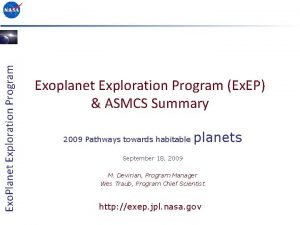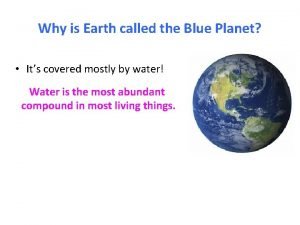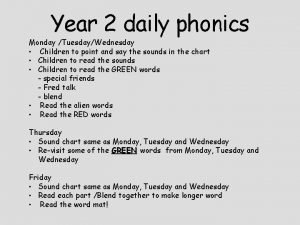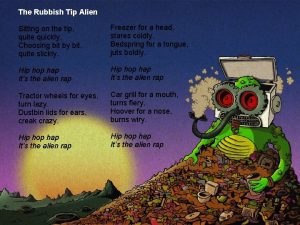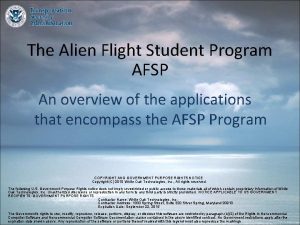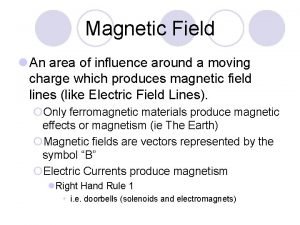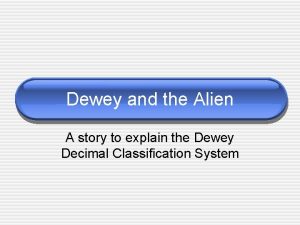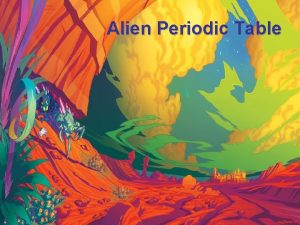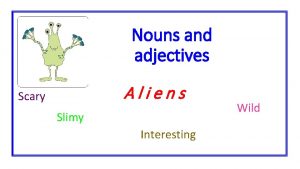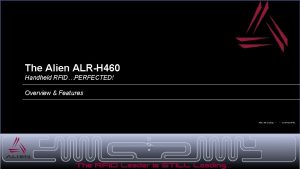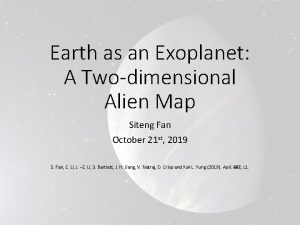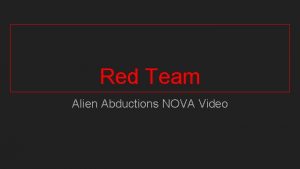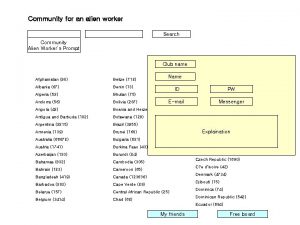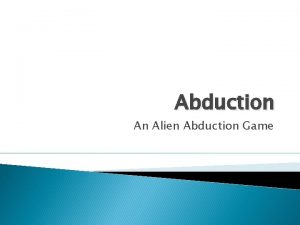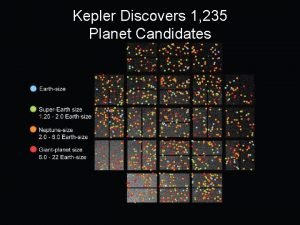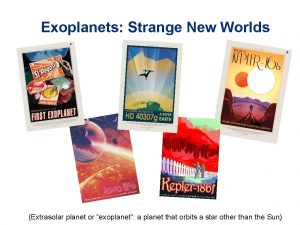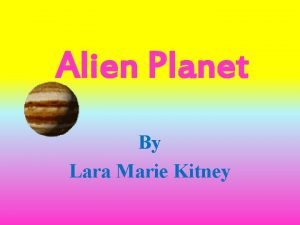Invent an Alien Define EXOPLANET A planet that




























- Slides: 28

Invent an Alien…

Define: EXOPLANET A planet that orbits a star other than our own sun l First one discovered in? l l 1992 l How many have we discovered so far? l 228

Plan for today l l Look at a couple of example of exoplanets Invent an Alien! l l Roll dice to determine the planet your alien lives on Design the alien Include a “smart part” – How does your alien get around? l Include a “smart action” – What (or how) does it eat? l l We’ll look at some examples before we invent the alien.

Exoplanets l First picture of one (maybe) taken in April 2004 l l l In orbit around brown dwarf 2 M 1207 A About 3 to 10 times the mass of Jupiter Takes about 1500 years to orbit its sun Brown dwarf http: //www. astronomy. com/asy/default. aspx? c=a&id=3105 http: //en. wikipedia. org/wiki/2 M 1207 b Planet?

Nov 2008 announcements http: //hubblesite. org/newscenter/archive/releases/2008/39/

http: //planetquest. jpl. nasa. gov/news/hot. Shots. cfm

We got lucky Most planets are too close to their sun, and their sun too bright, to allow us to take a picture l Scientists use a variety of techniques to detect a planet l Right now the techniques available work best for large planets that are close to their sun l

Light l Light, like sound, can be broken up into unique frequencies (colors) http: //en. wikipedia. org/wiki/Image: Light_dispersion_conceptual_waves. gif

Detecting the wobble l When an object orbits another object, they actually both orbit a common “center of mass”.

We can detect that wobble l Change in frequency (of sound or light) of a moving object called the “Doppler Effect” l for l example a police car with siren driving by And there are other techniques that can be used too

Doppler effect

Artist impressions of exoplanets It will be a long time before we can take a direct picture of an exoplanet l We really don’t know what the planets look like l l We can make educated guesses

HD 69830 d is an exoplanet orbiting the orange dwarf star HD 69830 (located 41 light years) every 197 days. It is the outermost known planet in its planetary system and possibly lies within its habitable zone. The system includes what is believed to be an asteroid belt. Compared to our own solar system's asteroid belt, this one is larger and closer to its star -- it is 25 times as massive, and lies just inside an orbit equivalent to that of Venus. http: //www. spitzer. caltech. edu/Media/releases/ssc 2005 -10 c. shtml

Planet OGLE-2005 -BLG-390 Lb. Its star is most likely a red dwarf. It’s orbit is 2 to 4 times the size of Earth’s, meaning it gets little energy from its sun. Therefore the surface temperature is estimated as -220 C (-364 F)

Enough about planets, how about the aliens that live on them? OK, we don’t know what might live there… l Next 4 pictures and descriptions are from the following two books: l l Barlowe’s Guide to Extraterrestrials by Wayne Douglas Barlowe. l The ALIEN Life of Wayne Barlowe by Wayne Douglas Barlowe.

http: //www. waynebarlowe. com/

http: //www. waynebarlowe. com/

http: //www. waynebarlowe. com/

http: //www. waynebarlowe. com/

Life on Earth can seem pretty unusual too… http: //www 7. national geographic. com/ngm /0702/feature 4/galler y 1. html Thelepus setosus, up to 1 foot (30 cm), tentacles up to 3 feet (0. 9 meters) long. Corkscrew gills and grooved feeding tentacles splay from a spaghetti worm, one of the many thousands of worm species that live at sea. This reef dweller protects its six-inch (15 centimeters) body in a sand-mucus tube while its appendages drift, snagging detritus and distracting foes.

Convolutriloba longifissura, 0. 08 -0. 12 in (0. 2 -0. 3 cm). An acoel is a tiny flatworm without a gut. Denizen of stony shallows, photosynthetic algae in its skin help nourish it. http: //www 7. national geographic. com/ngm /0702/feature 4/galler y 1. html

Chaetopterus variopedatus, up to 9. 8 in (25 cm) long http: //www 7. national geographic. com/ngm /0702/feature 4/galler y 1. html The intricate parchment worm, this one about five inches (13 centimeters) long, is typically well-hidden in a U-shaped tube in the sand—through which it pumps water using paddles at the center of the body. Edible bits are caught and balled up in sticky mucus bags that form below the rectangular head. When disturbed, this remarkable animal can expel bioluminescent mucus.


Postscript

Habitable zones (habitable for life as we know it, i. e. where the temperature where water is a liquid) http: //en. wikipedia. org/wiki/Habitable_zone

Scientific American Magazine April 2008 Issue http: //www. sciam. com/article. cfm? id=the-color-of-plants-on-other-worlds

l On a world with a (smaller) cooler, dim star the plants might need to be black

l Planets around very young small stars would be bathed in ultraviolet light, making the only safe place underwater
 Exoplanet exploration program
Exoplanet exploration program Why earth called blue planet
Why earth called blue planet Phân độ lown
Phân độ lown Block nhĩ thất độ 2 mobitz 2
Block nhĩ thất độ 2 mobitz 2 Thơ thất ngôn tứ tuyệt đường luật
Thơ thất ngôn tứ tuyệt đường luật Thơ thất ngôn tứ tuyệt đường luật
Thơ thất ngôn tứ tuyệt đường luật Walmart thất bại ở nhật
Walmart thất bại ở nhật Tìm độ lớn thật của tam giác abc
Tìm độ lớn thật của tam giác abc Con hãy đưa tay khi thấy người vấp ngã
Con hãy đưa tay khi thấy người vấp ngã Tôn thất thuyết là ai
Tôn thất thuyết là ai Gây tê cơ vuông thắt lưng
Gây tê cơ vuông thắt lưng Sau thất bại ở hồ điển triệt
Sau thất bại ở hồ điển triệt Alien word mat
Alien word mat Grurb
Grurb The rubbish tip alien
The rubbish tip alien Alien flight student program
Alien flight student program Kron the alien freedom fighter
Kron the alien freedom fighter Legal alien poem
Legal alien poem Dewey and the alien
Dewey and the alien J jeptum
J jeptum What major events happened during john adams presidency
What major events happened during john adams presidency Adjectives for aliens
Adjectives for aliens Federalist cartoon
Federalist cartoon Breakout edu answer key alien
Breakout edu answer key alien Alien and sedition acts political cartoon
Alien and sedition acts political cartoon Alien and sedition acts political cartoon
Alien and sedition acts political cartoon Alien h460
Alien h460 Counter migration ap human geography
Counter migration ap human geography Alien & sedition acts definition
Alien & sedition acts definition
